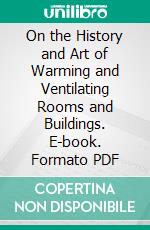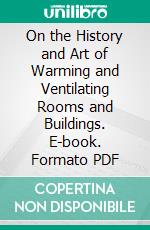On the History and Art of Warming and Ventilating Rooms and Buildings. E-book. Formato PDF - 9780243762729
di Walter Bernan
edito da FORGOTTEN BOOKS , 2017
Formato: PDF - Protezione: nessuna
All this suffering and inconvenience, the cardinal demonstrates, was produced in his and by-gone times by house-raisers feeling they had done their duty when they had provided hearths, without duly consi dering that the end sought by burning the fuel in a chimney was to warm the rooms and the persons in them. These builders never seem to have re?ected on the fact, that we receive the heat emanating from burning bodies in more ways than one. It may come directly from the fire or hot body, and then we are warmed by what is called radiant heat and it may be thrown off from a body on which it has fallen, and our sensation is produced by re?ected heat; or it may be conducted through a solid body, as when fuel is burned in a stove, and the hot surface heats the air whichsurrounds and warms us. Fuel burned on a common hearth, enclosed on three sides, does not warm the room by conducted heat. It emits but a very small part of its radiant heat into the apartment, and nearly all the re?ected heat is retained in the hearth recess. In the cardinal's fireplace, not only a much greater proportion of radiant and re?ected heat were applied to their proper purpose, but the air was heated by conduction also. The jambs of the hearth recess were always built parallel, and at right angles to the back. The width of the Opening varied from 3 feet 6 inches to 8 feet, and seldom had a less depth than 2 feet 3 inches, and was from 4 to 7 feet high. From the position of the jambs and their depth, it will be apparent that they could re?ect little heat from their plastered surface; more of the heat was re?ected from the back; but from the position of the fuel, alarge proportion of the incident rays made a very acute angle with the back, and consequently was re?ected into the chimney throat. Of the radiant heat, only that small portion which emanated in a direction little removed from the horizontal, had any effect in warming the room. A slight inclination of the heating rays at their focus carried them over the heads of those sitting round the fire, and they fell on the wall at too great a height to produce any effect that could be appreciated by the company. Rounding the angles of these deep paral lel jambs, and lining them with plates of iron and brass to give them a neater appearance, slightly mended the faulty primitive construction.
Ean
9780243762729
Titolo
On the History and Art of Warming and Ventilating Rooms and Buildings. E-book. Formato PDF
Autore
Editore
Data Pubblicazione
2017
Formato
PDF
Protezione
nessuna
Punti Accumulabili


